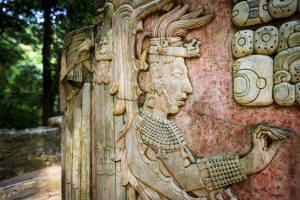Lidar, short for light detection and ranging – is a key tool for archeologists around the world. Using lidar technology in archeology is quickly taking the place of radar in the attempts to detect more buildings and other structures.
 In 2009, Colorado State University archaeologist Chris Fisher found out about Lidar. He was surveying the ruins of Angamuco in west-central Mexico the traditional way, with a line of grad students and assistants walking carefully while looking at the ground hoping to discover bits of ceramics, remains of old building foundations, or perhaps even a tomb.
In 2009, Colorado State University archaeologist Chris Fisher found out about Lidar. He was surveying the ruins of Angamuco in west-central Mexico the traditional way, with a line of grad students and assistants walking carefully while looking at the ground hoping to discover bits of ceramics, remains of old building foundations, or perhaps even a tomb.
He expected to find a settlement, but, instead he and his team happened upon a major city of the Purepecha empire, rivals of the Aztecs in the centuries immediately preceding the Spanish conquest of Mexico in 1519.
The site covered over 8 sq. miles. Traditional methods of surveying would have taken years, so Fisher turned to lidar technology for the project. The pulses of light penetrate the forest and ground cover revealing what lay beneath. “In two seasons we had surveyed only two square kilometres,” Fisher said. But with this new technology – lidar – “we mapped the entire city in 45 minutes.”
In the past century, archeologists have dug through the Guatemalan jungle searching through dense vegetation to learn all they could about the Maya civilization that was one of the most dominant societies in Mesoamerica for hundreds of years.
However, a recent discovery – being called a game changer by archeologists – didn’t even require a can of bug spray.
In this case, with the use of high-tech airplane based lidar, archeologists have discovered tens of thousands of structures constructed by the Maya. Defense works, houses, industrial-size agricultural fields, buildings, and even new pyramids. These findings are re-shaping long-held views about the size and scope of the Maya civilization.
“This world, which was lost to this jungle, is all of a sudden revealed in the data,” said Albert Yu-Min Lin, an engineer and National Geographic explorer who worked on a television special about the new find. “And what you thought was this massively understood, studied civilization is all of a sudden brand new again,” he told the New York Times.
The lidar pulses that shot at pieces of the Guatemalan jungle was done in a matter of days, stated Thomas Garrison, an archeologist at Ithaca College who led the project. He states, it unearthed Mayan structures that researchers had literally walked over before, including a temple they thought was a hill. He went on to say that this is truly a game changer. Using lidar in archeology changes the base level at which we continue the work.
The lidar system fires rapid laser pulses at surfaces, sometimes as many as 150,000 pulses per second; and measures how long it takes that light to return to the measuring equipment.
With there being multiple components in one lidar unit, employing the services of Universe Optics is the perfect choice. All the lenses necessary will be designed and manufactured with 100% precision, offering the clearest images possible for your specifications.
Besides using lidar in archeology, there are many other applications. Police use it in traffic speed guns; meteorologists use it to examine layers of the atmosphere and to search for concentrations of air pollution; Nasa uses it in docking devices at the International Space Station; the US military uses it to provide quick and detailed terrain mapping for troops.
It’s clear that lidar technology is leading the way and will continue to be a presence the 21st Century.